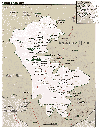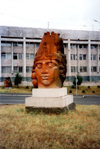| Xankandi
(Stepanakert, Khankandy) |
|
|
 Xankandi
is the capital city of the Nagorno-Karabakh
region (meaning 'Mountainous Black Garden', the Armenians prefer
the name 'Artsakh'). Formerly an autonomous region within Azerbaijan, the
Nagorno-Karabakh and some adjoining territories are currently outside the
control of the Azeri Government (see
international
disputes), and the former local Azeri population has been deslocated
eastwards.
Xankandi
is the capital city of the Nagorno-Karabakh
region (meaning 'Mountainous Black Garden', the Armenians prefer
the name 'Artsakh'). Formerly an autonomous region within Azerbaijan, the
Nagorno-Karabakh and some adjoining territories are currently outside the
control of the Azeri Government (see
international
disputes), and the former local Azeri population has been deslocated
eastwards.
 Xankandi
is a recent city, currently with a population of under 30.000 souls, significantly
less than in Soviet times. It was founded in 1917 after the October revolution
on the site of the village of the same name and was renamed Stepanakert
in 1923 for Stepan Shaumyan, a Baku Armenian communist leader. After Azerbaijan
gained independence the name was changed back to Xankandi, though the Armenians
continue to call the city Stepanakert.
Xankandi
is a recent city, currently with a population of under 30.000 souls, significantly
less than in Soviet times. It was founded in 1917 after the October revolution
on the site of the village of the same name and was renamed Stepanakert
in 1923 for Stepan Shaumyan, a Baku Armenian communist leader. After Azerbaijan
gained independence the name was changed back to Xankandi, though the Armenians
continue to call the city Stepanakert.
 Due
to the present military situation, to visit Xankandi you need to go via
Armenia (this is quite easy, but see the visas
section for details on the bureaucracy). The roads have been improved during
recent years and new roads were also built. The road distance from Yerevan
is about 200 km, so in the Armenian capital simply board a bus, minibus
("marshrutka") or rent a car. The road will take you via Goris, Lachin
and Shusha, and plenty of breathtaking landscape.
Due
to the present military situation, to visit Xankandi you need to go via
Armenia (this is quite easy, but see the visas
section for details on the bureaucracy). The roads have been improved during
recent years and new roads were also built. The road distance from Yerevan
is about 200 km, so in the Armenian capital simply board a bus, minibus
("marshrutka") or rent a car. The road will take you via Goris, Lachin
and Shusha, and plenty of breathtaking landscape.
As a more expensive, but faster, alternative
you can get helicopter services between Yerevan and Xankandi (flights operated
by Russian built Mi-8s).
 Born
in a nest of mountains, today Xankandi is a large, clean and well kept
city that looks totally rebuilt. After Agdam was captured, the people of
Xankandi hauled back building materials and whatever they could salvage
to rebuild their city. Needless to say, there isn't much left of Agdam,
which is now in the buffer zone occupied by Armenian forces (although the
mosque with its elaborate wall mosaics has been preserved).
Born
in a nest of mountains, today Xankandi is a large, clean and well kept
city that looks totally rebuilt. After Agdam was captured, the people of
Xankandi hauled back building materials and whatever they could salvage
to rebuild their city. Needless to say, there isn't much left of Agdam,
which is now in the buffer zone occupied by Armenian forces (although the
mosque with its elaborate wall mosaics has been preserved).
The shops in Nagorno Karbakh's capital
are well stocked - you'll notice a lot of Iranian and Turkish goods! Have
a walk trough the bustling open market to capture the spirit of the city.
 The
city is rather lively, with the valuable contribution of the students of
the Artsakh State University which
has become a reputable education and research institution. There are musical
and medical schools, a football stadium, and a Soviet style Youth Palace.
The people are quite friendly, but the nationalist feelings are still very
strong, so expect the conversation to drift towards politics.
The
city is rather lively, with the valuable contribution of the students of
the Artsakh State University which
has become a reputable education and research institution. There are musical
and medical schools, a football stadium, and a Soviet style Youth Palace.
The people are quite friendly, but the nationalist feelings are still very
strong, so expect the conversation to drift towards politics.
Being a recent city Xankandi lacks the
heritage present all over Nagorno Karabakh, but there are a few places
worth visiting: the Veratsnound Sq., the Historical Museum of the
Artsakh, the “Vahram Papazian” Drama Theatre, the monument
of the local freedom fighter Ashot Ghulian (Bekor) and the Memorial Monument
to the killed soldiers of Artsakh.
 Near
the road to Shusha lies the monument that has become the symbol of Artsakh
- nicknamed “Tatik Papik” (Grandmother and Grandfather), it was created
in Soviet times by sculptor Sarkis Baghdasarian, a named "We Are Our Hills",
symbolizing the attachment to the Karabakh land (it was inagurated by then
communist leader Heydar Aliyev).
Near
the road to Shusha lies the monument that has become the symbol of Artsakh
- nicknamed “Tatik Papik” (Grandmother and Grandfather), it was created
in Soviet times by sculptor Sarkis Baghdasarian, a named "We Are Our Hills",
symbolizing the attachment to the Karabakh land (it was inagurated by then
communist leader Heydar Aliyev).
Xankandi has a varied industrial structure
and is especialy important for food processing, wine making, and silk weaving.
It produces furniture and footware.
(350 km west of Baku)
| A to Z of Azerbaijan
/ A dan Z ye Azerbaycan |
www.azerb.com
|
 Xankandi
is a recent city, currently with a population of under 30.000 souls, significantly
less than in Soviet times. It was founded in 1917 after the October revolution
on the site of the village of the same name and was renamed Stepanakert
in 1923 for Stepan Shaumyan, a Baku Armenian communist leader. After Azerbaijan
gained independence the name was changed back to Xankandi, though the Armenians
continue to call the city Stepanakert.
Xankandi
is a recent city, currently with a population of under 30.000 souls, significantly
less than in Soviet times. It was founded in 1917 after the October revolution
on the site of the village of the same name and was renamed Stepanakert
in 1923 for Stepan Shaumyan, a Baku Armenian communist leader. After Azerbaijan
gained independence the name was changed back to Xankandi, though the Armenians
continue to call the city Stepanakert.
 Xankandi
is the capital city of the Nagorno-Karabakh
region (meaning 'Mountainous Black Garden', the Armenians prefer
the name 'Artsakh'). Formerly an autonomous region within Azerbaijan, the
Nagorno-Karabakh and some adjoining territories are currently outside the
control of the Azeri Government (see
international
disputes), and the former local Azeri population has been deslocated
eastwards.
Xankandi
is the capital city of the Nagorno-Karabakh
region (meaning 'Mountainous Black Garden', the Armenians prefer
the name 'Artsakh'). Formerly an autonomous region within Azerbaijan, the
Nagorno-Karabakh and some adjoining territories are currently outside the
control of the Azeri Government (see
international
disputes), and the former local Azeri population has been deslocated
eastwards.



